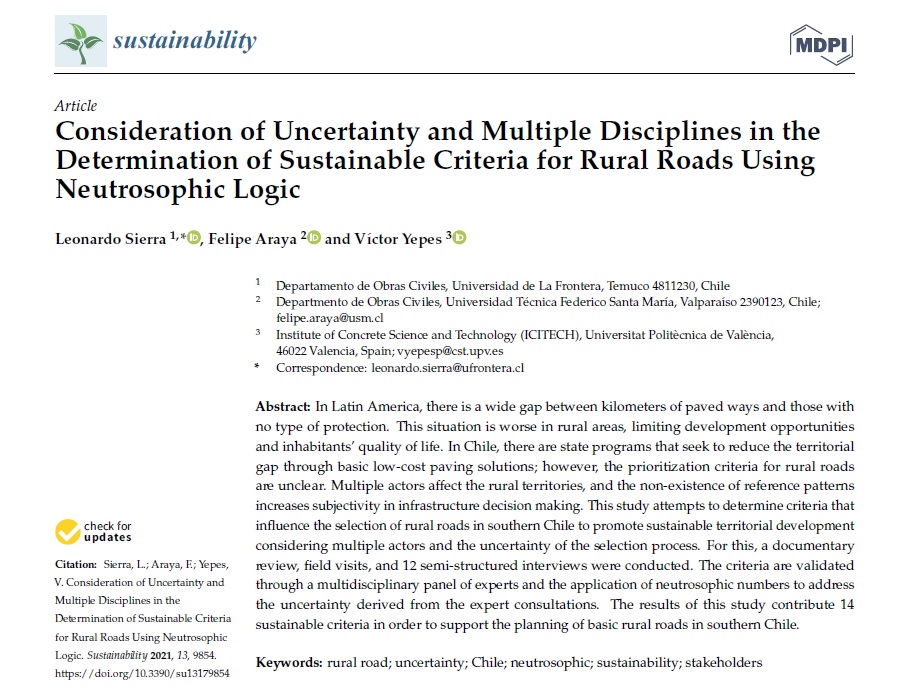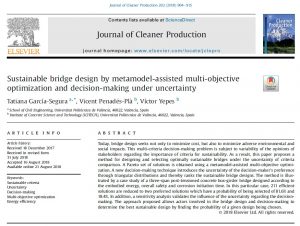 Acaban de publicarnos un artículo en la revista Sustainability, revista indexada en el JCR. En este caso se ha considerado la incertidumbre en la determinación de los criterios para la sostenibilidad en carreteras rurales usando la lógica neutrosófica. El trabajo se enmarca dentro del proyecto de investigación HYDELIFE que dirijo como investigador principal en la Universitat Politècnica de València.
Acaban de publicarnos un artículo en la revista Sustainability, revista indexada en el JCR. En este caso se ha considerado la incertidumbre en la determinación de los criterios para la sostenibilidad en carreteras rurales usando la lógica neutrosófica. El trabajo se enmarca dentro del proyecto de investigación HYDELIFE que dirijo como investigador principal en la Universitat Politècnica de València.
En Latinoamérica existe una gran diferencia entre los kilómetros de vías pavimentadas y los que no tienen ningún tipo de protección. Esta situación se agrava en las zonas rurales, limitando las oportunidades de desarrollo y la calidad de vida de los habitantes. En Chile, existen programas estatales que buscan reducir la brecha territorial a través de soluciones básicas de pavimentación de bajo costo; sin embargo, los criterios de priorización aplicables a los caminos rurales son poco claros. Son múltiples los actores que intervienen en los espacios rurales, y la inexistencia de patrones de referencia aumenta la subjetividad en la toma de decisiones de este tipo de infraestructuras. Este estudio intenta determinar los criterios que influyen en la selección de caminos rurales en el sur de Chile para promover el desarrollo territorial sostenible considerando los múltiples actores y la incertidumbre del proceso de selección. Para ello, se realizó una revisión documental, visitas a terreno y 12 entrevistas semiestructuradas. Los criterios se han validado a través de un panel multidisciplinario de expertos y la aplicación de números neutrosóficos para abordar la incertidumbre derivada de estas consultas. Los resultados de este estudio aportan 14 criterios basados en la sostenibilidad para apoyar la planificación de caminos rurales básicos en el sur de Chile.
Abstract:
In Latin America, there is a wide gap between kilometers of paved ways and those with no type of protection. This situation is worse in rural areas, limiting development opportunities and inhabitants’ quality of life. In Chile, there are state programs that seek to reduce the territorial gap through basic low-cost paving solutions; however, the prioritization criteria for rural roads are unclear. Multiple actors affect the rural territories, and the non-existence of reference patterns increases subjectivity in infrastructure decision making. This study attempts to determine criteria that influence the selection of rural roads in southern Chile to promote sustainable territorial development considering multiple actors and the uncertainty of the selection process. For this, a documentary review, field visits, and 12 semi-structured interviews were conducted. The criteria are validated through a multidisciplinary panel of experts and the application of neutrosophic numbers to address the uncertainty derived from the expert consultations. The results of this study contribute 14 sustainable criteria in order to support the planning of basic rural roads in southern Chile.
Keywords:
Rural road; uncertainty; Chile; neutrosophic; sustainability; stakeholders
Reference:
SIERRA, L.; ARAYA, F.; YEPES, V. (2021). Consideration of uncertainty and multiple disciplines in the determination of sustainable criteria for rural roads using neutrosophic logic. Sustainability, 13(17):9854. DOI:10.3390/su13179854


